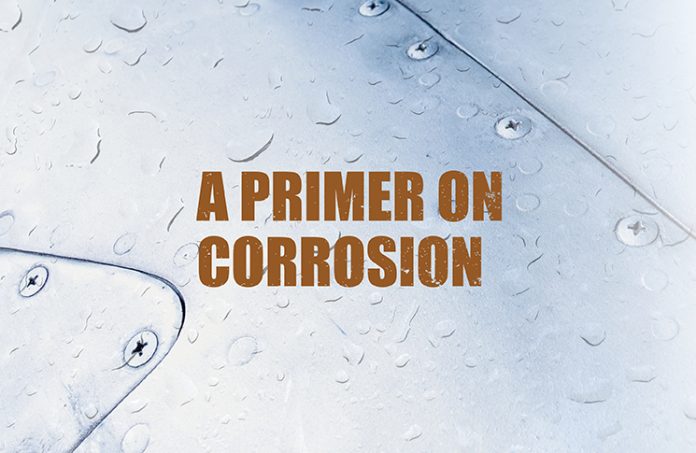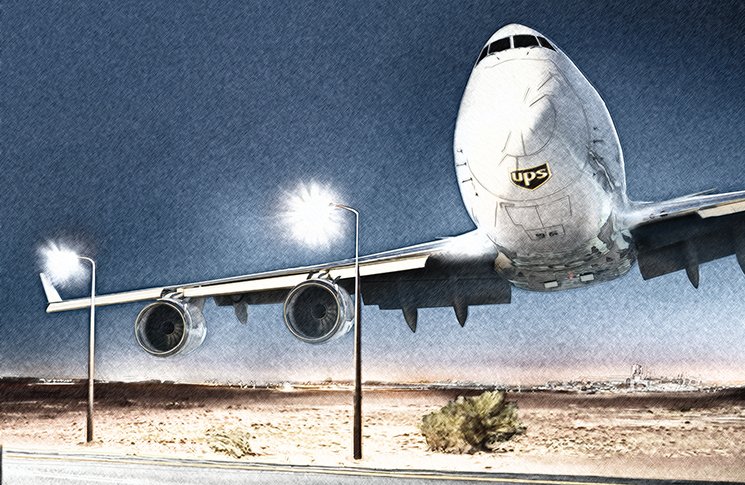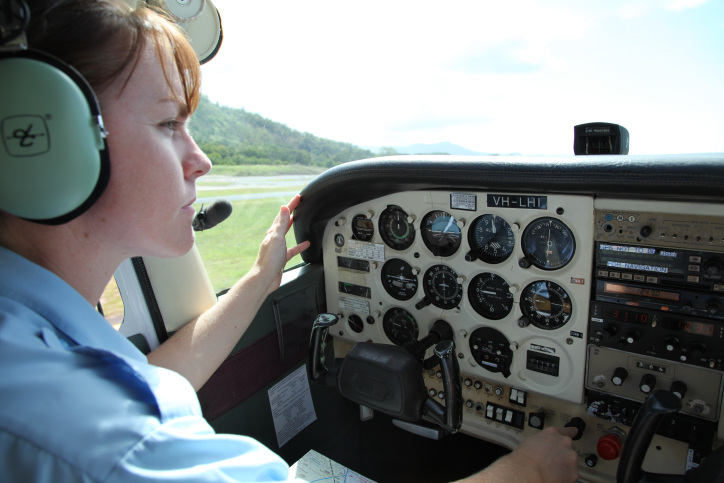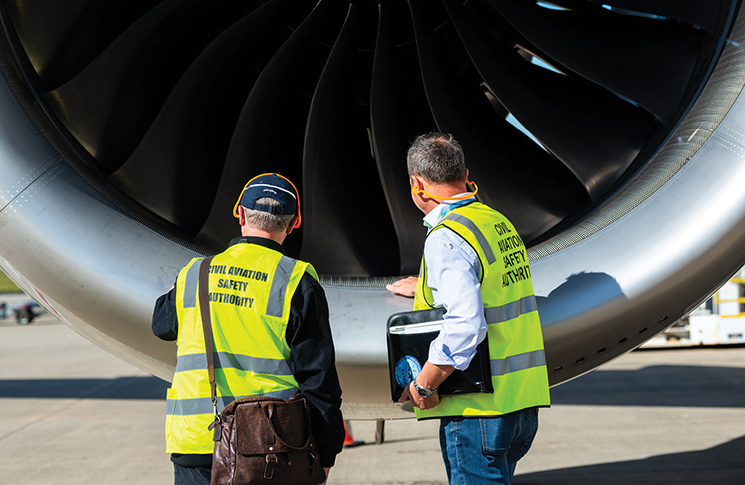It’s the enemy of most metals, never sleeps, loves damp conditions and wants to eat your aircraft.
If this story had been written 5 years ago, it might well have started with the line that aircraft corrosion is an issue despite Australia being the driest inhabited continent on Earth. In 2023 that doesn’t ring true, with large parts of Australia flooded and record-breaking rain over much of the rest – although at time of writing the Top End and parts of Tasmania had unusually dry conditions.
If aircraft corrosion was a problem in those drier times, it’s a serious problem in 2023: the aircraft fleet is older and, in most of the country, is operating and being stored in more humid conditions. And exposure to water, whether as atmospheric humidity or directly as rainfall, accelerates corrosion.
Corrosion does its work in the parts of an aircraft structure where poor drainage and airflow allow water to accumulate, through ingress or condensation.
Aircraft operating in coastal areas, particularly the warm, humid climates of northern Australia, are most at risk of severe corrosion; however, the presence of high concentrations of salt in the soils of some other Australian regions mean even aircraft operating there are at risk. Corrosion does its work in the parts of an aircraft structure where poor drainage and airflow allow water to accumulate, through ingress or condensation. In addition, dust can collect and form mud, creating an environment of constant damp that facilitates corrosion.
More than rust
Corrosion is a natural process where a refined metal breaks down to a more stable form such as its oxide, hydroxide or sulphide. Corrosion can occur from a reaction with another substance such as oxygen, hydrogen, another metal, dirt or bacteria. While the aluminium alloys used in aircraft do not rust like iron or steel, their corrosion shows up first as a darkening on the surface, then as a grey powdery substance, and more severely as pitting, cracking, flaking or pinholes.
Corrosion can also happen when metals are placed under sustained stress in a corrosive environment, eventually causing the material to crack. Engineering and metallurgy consultancy TWI estimates the annual worldwide cost of metallic corrosion at more than $US2 trillion a year, up to 30 per cent of which could be prevented with proper corrosion protection.
An aircraft’s susceptibility to corrosion is influenced by a number of factors, including but not limited to, geographical location, season and usage.
Engineering and metallurgy consultancy TWI estimates the annual worldwide cost of metallic corrosion at more than $US2 trillion a year.
There are 6 main types of corrosion that affect aircraft structures:
- Surface corrosion: the most common type in aircraft which occurs when metal on the surface of an aircraft oxidises; this is enhanced when paint wears away. It shows itself as roughening, pitting or etching of surface metal and the presence of grey-white powdery deposits on aluminium. Sometimes the corrosion will spread under the surface coating. This shows up as paint or plating lifted off the surface in small blisters which result from the pressure of the underlying accumulation of corrosion products.
- Filiform corrosion: a form of surface corrosion which resembles small worms underneath the paint surface, eventually leading to bubbling and cracking.
- Dissimilar metal corrosion: also called galvanic corrosion, appears when metal parts of different electrical potential come into contact with each other in the presence of moisture and an electrolyte, such as salt. Galvanic corrosion occurs mostly in salt water but can also pose a problem over the lifetime of an aircraft flown and stored in less harsh conditions. This type of electrochemical corrosion can cause extensive pitting damage. It often takes place out of sight, making it particularly dangerous. It can arise from using steel wool or a steel wire brush on aluminium or magnesium which, if not thoroughly rinsed or wiped down, can force small pieces of steel into the metal being cleaned; these further corrode and ruin the adjoining surface.
- Intergranular corrosion: affects the grain boundaries of an alloy and is related to a lack of uniformity in alloy structure. It occurs when impurities are present at the grain boundaries which form during solidification of an alloy. Although intergranular corrosion often exists without surface evidence, it can lead to the lifting and flaking of surface metal. Extruded components such as wingspars may be particularly susceptible.
- Stress corrosion: develops when parts such as landing gear and engine crankshafts are put under sustained tensile stress in corrosive environments. It reveals itself in cracking and failure. Bellcranks with pressed-in bushings, landing gear shock struts with pipe thread type grease fittings, clevis pin joints and shrink fits are examples of parts which are susceptible to stress corrosion cracking.
- Fretting corrosion: caused by the slight relative motion of 2 mating surfaces on an aircraft. Since the restricted movements of the surfaces prevent the debris from escaping easily, an extremely localised abrasion occurs. The presence of water vapour greatly increases this type of deterioration.
Prevention
Ten ways to minimise corrosion of an aircraft:
- Keep it clean – dirt, grease, insects and bird droppings are corrosion’s enablers. Give the airframe a sponge, bucket and hose wash to remove these, then a thorough rinse with clean water. An awkward but necessary task is often the removal of oil streaks on the fuselage behind the engine’s exhaust. Washing also provides an opportunity to look closely at the airframe and finish.
- Inspect closely – this combines well with the act of cleaning the aircraft but should also be a part of your pre-flight inspection. Scheduled maintenance should include more detailed corrosion inspections in the aircraft’s hidden places.
- Treat corrosion promptly – this could range from washing for very minor outbreaks, abrasive removal and repainting, to replacement of severely corroded structural parts.
- Touch-up any damaged paint areas – paint acts as a seal against corrosion, so thinness or holes in the paint are damage to the seal.
- Keep drain holes free of obstructions – blocked drain holes (in fuselages, doors and compartments) can allow water to accumulate, with corrosion the likely result if water sits for long periods.
- Drain water from fuel tanks often – water formation in fuel is not only a hazard to flight, but also a facilitator of corrosion.
- Wipe down exposed critical areas – leading edges, control surface hinges, cowlings, engine cylinder fins, fuel fillers and caps, battery boxes.
- Use protective covers – protect your parked aircraft from sun, wind and corrosion-causing rain, but be sure it gets ventilation on warm, sunny days.
- Hangar the aircraft – yes, it’s an expensive option and unavailable in many areas, but parking on the tarmac, or worse on grass, means you will eventually pay in other ways.
There is no single solution that will ensure corrosion prevention on an installed aircraft engine.
Engines
Corrosion also affects aircraft engines. Finned air-cooled engines have a lot of surface area by design and, therefore, a lot of exposure to corrosion from humid – and perhaps salty – air. Add the engine’s vibration to the pitting damage of corrosion and conditions are ripe for stress corrosion cracking and fatigue failure. CASA Airworthiness Bulletin 85‑017 Issue 1 of 2014 has a sobering assessment of engine corrosion.
Prevention is far cheaper than cure, the bulletin says. ‘After any period during which regular corrosion-preventive maintenance is interrupted, the amount of maintenance required to repair accumulated corrosion damage will usually be quite intensive and costly.’
There is no single solution that will ensure corrosion prevention on an installed aircraft engine. The owner/operator is ultimately responsible to recognise the conditions that are conducive to corrosion and take appropriate precautions and actions, as necessary.
Flood
Some unfortunate operators had their aircraft damaged by floods in 2022. Some were written off with damage beyond economical repair, but any aircraft exposed to floodwater requires a thorough inspection before returning to service.
CASA Airworthiness Bulletin 02‑66 Issue 1 sets out details of this inspection:
- refer to aircraft manufacturer’s published maintenance/service manuals for instructions on disassembly of the airframe
- remove interior components to expose aircraft structure
- remove flight controls, wings, rudder, elevators and horizontal and vertical stabilisers, as necessary, to facilitate better cleaning of individual structural subassemblies
- remove subcomponents including, but not limited to, mechanical actuators, bellcranks, pushrods
- thoroughly wash all internal and external areas of the aircraft using an approved water/detergent solution. If the aircraft manufacturer does not specify a liquid detergent product, use water-emulsion cleaning compound MIL-C-43616
- thoroughly rinse all areas with fresh potable water, dry and apply corrosion inhibitive material, as necessary
- replace bearings, including, but not limited to roller, needle and bushing-type bearings
- check for structural damage (in the absence of specific post-flooding structural checks) following overspeed or overweight landings
- inspect for any corrosion; remove and treat or replace affected parts in accordance with applicable service/maintenance/structural repair manuals.
- Read the airworthiness bulletin at casa.gov.au/airworthinesss






https://www.youtube.com/watch?v=moLbdqZ9JCc
Interesting – no mention of well proven corrosion inhibiting products. Why not?